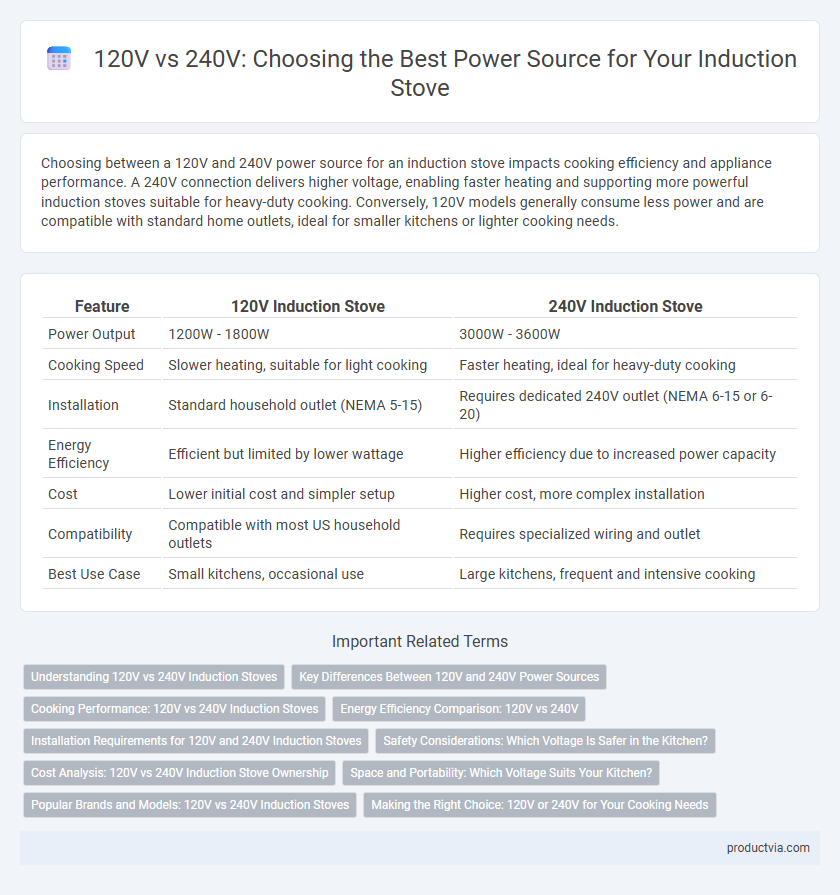Choosing between a 120V and 240V power source for an induction stove impacts cooking efficiency and appliance performance. A 240V connection delivers higher voltage, enabling faster heating and supporting more powerful induction stoves suitable for heavy-duty cooking. Conversely, 120V models generally consume less power and are compatible with standard home outlets, ideal for smaller kitchens or lighter cooking needs.
Table of Comparison
| Feature | 120V Induction Stove | 240V Induction Stove |
|---|---|---|
| Power Output | 1200W - 1800W | 3000W - 3600W |
| Cooking Speed | Slower heating, suitable for light cooking | Faster heating, ideal for heavy-duty cooking |
| Installation | Standard household outlet (NEMA 5-15) | Requires dedicated 240V outlet (NEMA 6-15 or 6-20) |
| Energy Efficiency | Efficient but limited by lower wattage | Higher efficiency due to increased power capacity |
| Cost | Lower initial cost and simpler setup | Higher cost, more complex installation |
| Compatibility | Compatible with most US household outlets | Requires specialized wiring and outlet |
| Best Use Case | Small kitchens, occasional use | Large kitchens, frequent and intensive cooking |
Understanding 120V vs 240V Induction Stoves
Induction stoves powered by 120V sources typically offer lower wattage, around 1,800 to 1,900 watts, resulting in slower heating and less power for high-heat cooking compared to 240V models. A 240V induction stove can deliver between 3,000 to 3,800 watts, providing faster heat-up times and higher cooking performance suitable for intensive culinary tasks. Understanding the voltage difference is essential for matching your kitchen's electrical capacity with the stove's power requirements, ensuring optimal efficiency and safety.
Key Differences Between 120V and 240V Power Sources
120V induction stoves are suitable for standard kitchen outlets and provide moderate power output, typically up to 1800 watts, making them ideal for casual cooking and small households. In contrast, 240V induction stoves deliver higher power, often exceeding 3600 watts, enabling faster heating and supporting more demanding cooking tasks in larger kitchens or professional settings. The voltage difference also affects installation requirements, where 240V units need dedicated circuits and specialized wiring to handle increased electrical load safely.
Cooking Performance: 120V vs 240V Induction Stoves
240V induction stoves deliver higher wattage, enabling faster and more consistent heating compared to 120V models, which often have lower power output and slower cooking times. The increased voltage in 240V units supports larger cookware and higher temperature settings, offering superior cooking performance for complex recipes. However, many compact or portable 120V induction stoves still provide sufficient heat for everyday cooking but may struggle with high-demand tasks.
Energy Efficiency Comparison: 120V vs 240V
Induction stoves operating at 240V generally deliver higher energy efficiency compared to 120V models due to reduced current flow and minimized electrical resistance losses. The 240V power source enables faster heat generation and more consistent cooking performance, resulting in lower energy consumption over time. This voltage advantage translates to cost savings and enhanced environmental benefits by optimizing power usage during cooking tasks.
Installation Requirements for 120V and 240V Induction Stoves
120V induction stoves typically require a standard household electrical outlet and are easier to install with minimal wiring adjustments, making them suitable for most kitchens without electrical upgrades. In contrast, 240V induction stoves demand a dedicated circuit with a double-pole breaker and specialized wiring to handle higher voltage and current, necessitating professional installation to meet electrical codes. Proper installation is crucial for safety and optimal stove performance, with 240V models offering faster heating capabilities but requiring more complex electrical infrastructure.
Safety Considerations: Which Voltage Is Safer in the Kitchen?
Induction stoves operating at 120V typically draw less current, reducing the risk of electrical overloads and making them safer for standard residential wiring. In contrast, 240V induction stoves deliver more power efficiently but require dedicated circuits and proper grounding to prevent electric shock hazards. Proper installation and adherence to electrical codes are crucial for safety regardless of the voltage used.
Cost Analysis: 120V vs 240V Induction Stove Ownership
Choosing a 120V induction stove often involves lower initial installation costs due to compatibility with standard household outlets, while 240V models require specialized wiring and higher electrical service fees. Operating costs may favor 240V induction stoves as they deliver more consistent power and heat efficiency, resulting in faster cooking times and reduced energy consumption. Long-term ownership expenses include potential electrical upgrades for 240V units, balanced against the operational savings from improved performance compared to 120V appliances.
Space and Portability: Which Voltage Suits Your Kitchen?
120V induction stoves offer greater portability and compatibility with standard residential outlets, making them ideal for smaller kitchens or mobile setups. In contrast, 240V models deliver higher power efficiency and faster cooking times but require dedicated wiring, limiting installation flexibility. Choosing between 120V and 240V depends on the balance between space constraints, cooking demands, and electrical infrastructure in your kitchen.
Popular Brands and Models: 120V vs 240V Induction Stoves
Popular brands like Duxtop and NuWave offer 120V induction stoves suitable for standard household outlets, providing portability and ease of use. Higher-powered models from brands such as GE and Bosch often require a 240V power source, delivering faster heating and supporting larger cookware. Choosing between 120V and 240V depends on kitchen wiring compatibility and desired cooking performance.
Making the Right Choice: 120V or 240V for Your Cooking Needs
Choosing between a 120V and 240V induction stove depends on your cooking habits and kitchen electrical setup. A 240V induction stove delivers higher power output, enabling faster heating and better performance for large pots or frequent cooking. In contrast, a 120V model suits smaller kitchens and lighter cooking tasks, offering easier installation without requiring specialized wiring.
120V vs 240V for induction stove power source Infographic

 productvia.com
productvia.com